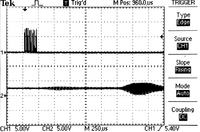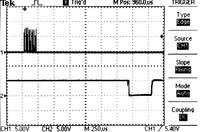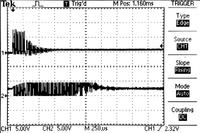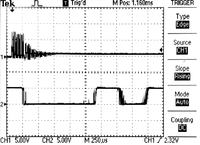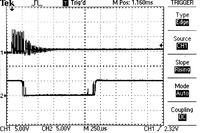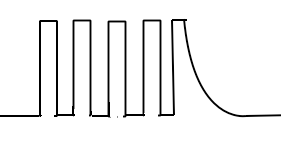Shahar Levi
Newbie level 5
Hi,
I am trying to build an ultrasonic detector with only one transceiver with switching between Tx and Rx. I am using MSP430 to generate 8 pulses at 40kHz and the switch control signal, CD4053 switch, mcp604 op-amp and Ekulit A-16PT transceiver with 1k Ohm nominal impedance.
While when using 2 sensors and no switch I have no problems at all, I get problems when I am trying to use switch and 1 transceiver. There are some sort of ringing right after the transmission which lasts a bit more that 1 millisecond and generate some noise in the receiving circuit and does not allow detection in the range of the nearest 30 cm to the sensor. after the 30 cm I am able to detect again but 30 cm is way too much of detection range to lose.
could someone give me a hint on how to remove this ringing noise and allow detection, or at least how to narrow it a bit down from 1 ms?
thank you very much.
p.s
1) so far the circuit was tested on a breadboard
2) the 2 npn transistors in series coming from P1.7 are there first to drive the transmission from 3v to 9v and then to invert the signal
3)I was trying to reduce the amplification gain or to use only 1 op-amp and it showed some improvement but not enough.
the Schematics:
**broken link removed**
no problems - ultrasonic with 2 sensors. the upper signal is the transmission and bottom is the measuring before diode D1 with object at 40 cm:
**broken link removed**
no problems - ultrasonic with 2 sensors. the upper signal is the transmission and bottom is the measuring at the OUT with object at 40 cm:
**broken link removed**
1 transceiver with switching. the upper signal is the transmission and bottom is the measuring before Diode D1 with object at 40 cm:
**broken link removed**
1 transceiver with switching. the upper signal is the transmission and bottom is the measuring before Diode D1 without object:
**broken link removed**
1 transceiver with switching. the upper signal is the transmission and bottom is the measuring at the OUT with object at 40 cm:
**broken link removed**
1 transceiver with switching. the upper signal is the transmission and bottom is the measuring at the OUT without object:
**broken link removed**
I am trying to build an ultrasonic detector with only one transceiver with switching between Tx and Rx. I am using MSP430 to generate 8 pulses at 40kHz and the switch control signal, CD4053 switch, mcp604 op-amp and Ekulit A-16PT transceiver with 1k Ohm nominal impedance.
While when using 2 sensors and no switch I have no problems at all, I get problems when I am trying to use switch and 1 transceiver. There are some sort of ringing right after the transmission which lasts a bit more that 1 millisecond and generate some noise in the receiving circuit and does not allow detection in the range of the nearest 30 cm to the sensor. after the 30 cm I am able to detect again but 30 cm is way too much of detection range to lose.
could someone give me a hint on how to remove this ringing noise and allow detection, or at least how to narrow it a bit down from 1 ms?
thank you very much.
p.s
1) so far the circuit was tested on a breadboard
2) the 2 npn transistors in series coming from P1.7 are there first to drive the transmission from 3v to 9v and then to invert the signal
3)I was trying to reduce the amplification gain or to use only 1 op-amp and it showed some improvement but not enough.
the Schematics:
**broken link removed**
no problems - ultrasonic with 2 sensors. the upper signal is the transmission and bottom is the measuring before diode D1 with object at 40 cm:
**broken link removed**
no problems - ultrasonic with 2 sensors. the upper signal is the transmission and bottom is the measuring at the OUT with object at 40 cm:
**broken link removed**
1 transceiver with switching. the upper signal is the transmission and bottom is the measuring before Diode D1 with object at 40 cm:
**broken link removed**
1 transceiver with switching. the upper signal is the transmission and bottom is the measuring before Diode D1 without object:
**broken link removed**
1 transceiver with switching. the upper signal is the transmission and bottom is the measuring at the OUT with object at 40 cm:
**broken link removed**
1 transceiver with switching. the upper signal is the transmission and bottom is the measuring at the OUT without object:
**broken link removed**

